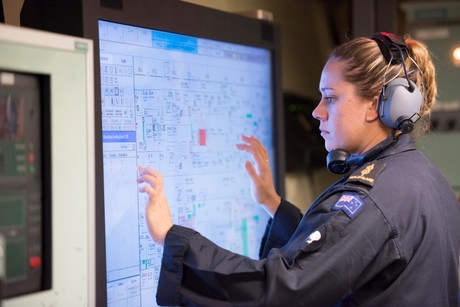Royal New Zealand Navy leads in adopting unmanned automation technology at sea

In its 75th anniversary year, the Royal New Zealand Navy (RNZN) notched up the accolade of becoming the first navy worldwide to adopt benchmark technologies that enable its warships Te Kaha and Te Mana to achieve unmanned machinery space — allowing technology to supervise the ships’ core operations. This significant upgrade, delivered by Siemens, offers RNZN the opportunity to adopt a new radical operational manning philosophy, unlike anything else worldwide.
Speaking on the occasion, Stephen Lenik, Commanding Officer, HMNZS Te Kaha, said, “Technologies have always been important throughout the ages, whether it’s a day of sail through to the first ironclad warships. But increasingly today, information superiority is of very high importance to navies throughout the world. In today’s contemporary maritime environment, for a navy to be relevant, we’ve got to be at that technological edge.”
One of the key drivers for the IPMS upgrades was freeing up crew, particularly within the marine engineering department, to carry out more maintenance at sea. There are also efficiency gains for command management and battle damage control. The full integration of the IPMS throughout the ship also allows for efficiencies to be realised in damage control. The Damage Control stations have a Battle Damage Control system providing a real-time status of all engineering plant including fire pumps and generators.
“The Siemens upgrades have been a real step change for us in the way we operate the ANZAC frigate; in particular I’ve noticed over my time in command that I’ve got greater awareness of the systems on board and that in turn has allowed my people to generate better maintenance routines and increase reliability of the ship. In turn, that means that New Zealand Navy has a frigate that is more available for the operation that it is required to undertake,” added CDR Lenik.
Siemens has played an important role in supporting major defence programs and upgrades in the region for over 30 years, from the ANZAC frigates to the pods on the helicopter landing docks. Siemens Chairman and CEO Jeff Connolly said that advanced technology and digitalisation is transforming all parts of industry including defence and the benefits are obvious. “By adopting the latest in digitalisation and IT technology, the NZ frigates are already seeing tangible benefits. This is a great example of the outcomes you can achieve when you collaboratively work together to design a superior solution to meet the exact needs of the customer. I congratulate the Royal New Zealand Navy on setting the benchmark in unmanned machinery.”
Head of Siemens Defence Andrew Seal noted that the upgrades have taken 75 man-hours per day off the ship. “It’s made the work for the marine technical sailors more enjoyable as it has removed the mundane tasking jobs and allowed them to concentrate on maintenance that would otherwise have to be conducted while alongside.”
Statistics show that 99% of New Zealand’s trade by volume and about 95% of trade by value comes via the sea. The navy is therefore a key government tool to ensure the safeguard of those maritime trade routes — free from any piracy or any illegal activity in that environment.
Green hydrogen innovation wins Climate Innovation Challenge
South East Water and RMIT University have developed a method for producing green hydrogen from...
Alpha HPA gets finance for high-purity alumina plant
Alpha HPA has announced that it has reached Contractual Close on finance to build Australia's...
Orica to bring digital mining technology to Türkiye
Orica Digital Solutions has signed an agreement with Turkish company KAPEKS on the introduction...








